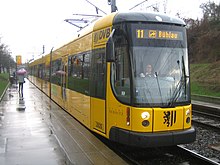Articulated railcar NGT D12DD
| Articulated railcar NGT D12DD | |
|---|---|
| Number: | 43 railcars |
| Manufacturer: | Bombardier Transportation |
| Year of construction (s): | 2003-2005, 2009-2010 |
| Length over coupling: | 45,090 mm |
| Height: | 3,500 mm |
| Width: | 2,300 mm |
| Empty mass: | 56.7 t |
| Top speed: | 70 km / h |
| Hourly output : | 8 × 85 kW = 680 kW |
| Operating mode: | Unidirectional locomotive |
| Seats: | 107 |
| Standing room: | 153 |
The NGT D12DD ( N iederflur g élénk t railcars D rehgestell 12 axes) is one of the dresdner verkehrsbetriebe operated (DVB) low-floor - tram . By 2005 the Dresdner Verkehrsbetriebe had acquired 32 of these railcars , and in spring 2008 a contract was signed for the delivery of 11 additional cars, which were delivered between July 2009 and May 2010. The trams carry the numbers 2801 to 2843 and belong to the second generation of low-floor trams in Dresden.
Structure and equipment
The articulated railcar NGT D12DD is a low-floor tram railcar operated by the Dresden Transport Company. It is of the Flexity Classic XXL type and was manufactured by Bombardier Transportation in the Bautzen plant. The Dresden variant of the railcar is adapted to the topographical conditions in Dresden and can be driven on steeper stretches and in tighter curves.
The NGT D12DD is 45.09 meters long. The tram car has five electromechanically operated double outer pivoting sliding doors. In contrast to the previous series ( NGT6DD and NGT8DD ) the vehicle has bogies . This results in better running and the more favorable load distribution reduces rail wear. Under the first and fifth vehicle module there are two motor bogies , each with an output of 2 × 85 kW. Two trailer bogies are housed in the middle vehicle module. The vehicle modules are connected via intermediate modules (floating sedan chairs).
A total of 260 passengers can be carried in this vehicle (seats: 107, standing: 153).
The railcars are equipped with modern information screens for stop and city information as well as for displaying advertisements . Disabled people are supported with the help of a blind information system (BLIS) and a fold-out wheelchair ramp .
The vehicles have video surveillance cameras . Video surveillance was retrofitted in the first five vehicles in 2009, and the following lanes were already equipped with cameras when they were delivered.
The basic type of tram is the Bombardier Flexity Classic , which has also been used in Dresden in a three-part, 30-meter-long version as the NGT D8DD since 2006 .
history
The first of 20 lanes in the first series was handed over to DVB on February 19, 2003. On June 19, 2003, the trial operation of the scheduled service began. Car 2801 initially ran on line 2 between Gorbitz and Prohlis . After a three-month trial run, more vehicles should be used on other lines.
Today, the vehicles are mainly used on Dresden tram lines 3, 7 and 11, occasionally also on lines 2 and 6 and at major events on other lines. In addition to the transport capacity, safety and the topography of Dresden also play a role as operational criteria. On lines 2 and 6, they are operated together with the older NGT8DD articulated multiple units, which have a similar transport capacity.
Naming
The first 32 tram cars procured NGT D12DD were given names. With one exception, these are named after Saxon towns; the first is named the city of Bautzen after its town of origin. The 100th modern low-floor wagon in Dresden was given the name Free State of Saxony , not least because of funding from the Free State .
- 2801 City of Bautzen
- 2802 City of Leipzig
- 2803 City of Chemnitz
- 2804 City of Zwickau
- 2805 City of Plauen
- 2806 City of Görlitz
- 2807 City of Bad Schandau
- 2808 City of Dresden
- 2809 City of Meissen
- 2810 City of Radebeul
- 2811 City of Coswig
- 2812 Weinböhla
- 2813 City of Pirna
- 2814 City of Kamenz
- 2815 City of Freital
- 2816 City of Riesa
- 2817 Free State of Saxony
- 2818 City of Hoyerswerda
- 2819 City of Heidenau
- 2820 City of Sebnitz
- 2821 City of Dippoldiswalde
- 2822 City of Freiberg
- 2823 City of Zittau
- 2824 City of Niesky
- 2825 City of Bischofswerda
- 2826 City of Löbau
- 2827 City of Radeberg
- 2828 City of Radeburg
- 2829 City of Tharandt
- 2830 City of Pulsnitz
- 2831 City of Grossenhain
- 2832 City of Glashütte
Leipzig variant
The Leipziger Verkehrsbetriebe also operate 33 of these low-floor trams. Technically, the vehicles largely correspond to the Dresden type. The appearance of the 45.09 meter long vehicles has been adjusted. Further differences can be found in the track width deviating by 8 millimeters (Dresden 1450 mm, Leipzig 1458 mm), the air conditioning of the Leipzig variant , as well as the additional entrances at the beginning and end of the vehicle through a single door element. It is called "Classic XXL" there, following the Bombardier product name.
On June 9, 2005, the first low-floor wagon of this type arrived at the Heiterblick depot and was integrated into the regular service in September .
literature
- Germany's longest tram for Dresden . In: Eisenbahn-Revue International , issue 1/2003, ISSN 1421-2811 , p. 42 f.
Web links
Individual evidence
- ^ Dresden: More trams NGT D12DD. In: Eurailpress. March 17, 2008, accessed April 6, 2014 .
- ^ Dresden: First tram delivered . In: Eisenbahn-Revue International , issue 4/2003, ISSN 1421-2811 , p. 152.
- ↑ Longest tram in the world in regular service . In: Eisenbahn-Revue International , issue 10/2003, ISSN 1421-2811 , p. 431.


